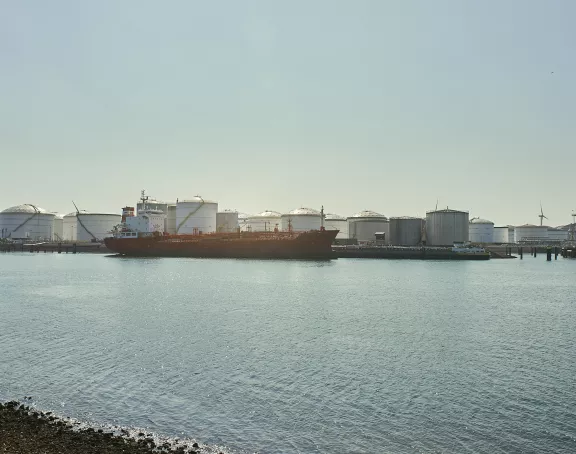The expansion of the ETS to include buildings, road transport and maritime transport: the bill to implement the amended ETS Directive
The bill to implement the changes to the European Emission Trading System (ETS) has been submitted to the Lower House. The bill envisages three major changes: from 2024 shipping companies will also have to surrender emission allowances, from 2024 airlines will be allocated fewer and fewer free emission allowances, and from 2027 emission allowances will have to be surrendered for the supply of fuel to the built environment, road transport and some other sectors.
Introduction
Our blog from 2021 covered the European Commission's proposed changes to the European Emissions Trading Scheme (ETS) in the context of Fit-for-55. As a result of negotiations between the European Parliament and the Council, the proposals were adopted in a slightly modified form in April 2023. This resulted in two directives amending Directive 2003/87/EC (the ETS Directive) and a regulation amending Regulation 2015/757 (relating to maritime transport under the ETS).
The bill to amend the Environmental Management Act in order to implement these directives and regulation was submitted to the Lower House on 5 September 2023. The Minister for Climate and Energy announced that only the binding provisions from the directives will be implemented and no rules other than those necessary for this implementation are included. The legislative amendments are scheduled to enter into force on 1 January 2024. In this blog post, we address the main changes to the ETS and where in national legislation the government plans to include them. The changes largely correspond to the proposed changes we addressed in our earlier blog. Below, we address consecutively the ETS for maritime transport, the ETS for buildings and road transport, the ETS for aviation and – briefly – the manner in which Carbon Border Adjustment Mechanismmodifies (CBAM) the ETS.
ETS for maritime transport
Maritime transport was already subject to a duty to monitor, report and verify emissions. With the legislative changes and expansion of the ETS, shipping companies are also required to surrender emission allowances.
What are the new rules?
- From 2024 shipping companies will be required to surrender emission allowances covering emissions from ships of 5,000 gross tonnage carrying cargo and/or passengers between EU ports and between EU ports and non-EU ports. The allowances must be surrendered by 1 October of the following year.
- Shipping companies report and surrender allowances to the Member State where they are registered. If they are not registered in a Member State, they are allocated to the Member State where they most frequently visited ports in the four previous monitoring years. Member States must arrange for a system of sanctions and effective exchange of information with other Member States to ensure, as far as possible, that shipping companies comply with all obligations under the ETS. The power to inspect ships in ports – including for the purpose of checking obligations under Regulation 2015/757 – currently lies with the Inspectorate for the Environment and Transport (ILT) (under the Port State Control Act and the Prevention of Pollution from Ships Act). The bill will not change this. Other supervisory tasks, such as approving the monitoring plan, are assigned to the Netherlands Emissions Authority (NEa) in the bill.
- For journeys within the EU, shipping companies have to surrender allowances for 100% of emissions; for journeys from the EU to ports outside the EU this is 50% of emissions.
- Implementation will be phased: in 2024, shipping companies will have to surrender allowances on 40% of emissions, in 2025 on 70%, and from 2026 on 100%.
- Shipping companies do not get free allowances because there is no risk of carbon leakage within shipping. All allowances must therefore be bought at auction.
- Smaller, offshore ships (between 400 and 5,000 gross tonnage) and so-called 'dry cargo ships' will also have to monitor, report and verify their emissions from 2025, ahead of their possible inclusion in the ETS (which the European Commission will assess in 2026).
Where can you find the new rules?
The changes are included in Regulation 2023/957 amending Regulation 2015/757 in regards to maritime transport activities under the ETS and Directive (EU) 2023/959 amending the ETS Directive (2003/87/EC). Chapter II of the ETS Directive now covers maritime transport (in addition to aviation). Because the regulation has direct effect, the legislature does not have to transpose all the provisions of that regulation into Dutch law. However, the government has chosen to include relevant definitions, such as 'shipping company' and 'port of call', in Chapter 16 of the Environmental Management Act (Wet milieubeheer; Wm). The bill also incorporates the surrender obligation for shipping companies – which follows from the ETS Directive – into the Wm. In the Explanatory Memorandum, the government notes that certain rules may be further elaborated in the Emissions Trading Scheme and the Prevention of Pollution from Ships Scheme.
ETS for buildings and road transport
The ETS will be expanded to cover emissions released from fuel combustion in the built environment, road transport, the energy industry (to the extent they are not already covered by the current ETS) and manufacturing and construction. The government calls this system the 'ETS2' as it will be a separate trading system from the existing ETS. This means that allowances under this system will be auctioned separately from allowances under the general ETS. As far as we are concerned, the choice of the term ETS2 is confusing, given that the general ETS is currently in its fourth trading period and is called ETS-IV. We will therefore refer to the new system below as the 'ETS for buildings and road transport'.
What are the new rules?
- The so-called 'regulated entities' will be subject to a licensing requirement from 2025. These are natural persons or legal entities that 'release fuel for consumption' and carry out 'designated activities' (we explain these definitions in more detail below). This amounts to suppliers of fuel to the extent that they supply fuel for designated activities. Regulated entities may no longer carry out those activities without a greenhouse gas emissions permit (emissions permit) from the NEa.
- From 2027, regulated entities will be required to surrender allowances on fuel released for consumption. The allowances must be surrendered by 1 June of the following year. Regulated entities must therefore surrender allowances for the first time by 1 June 2028, for the year 2027.
- The definition of 'releasing fuel for consumption' is included in the Wm and refers to the release of coal, supply of gas, consumption of gas, and release of mineral oils, which are subject to tax or excise duty under the Environmental Taxes Act. It follows that releasing fuel for consumption refers to the supply of fuel. The permit requirement and (ultimately) the obligation to surrender therefore explicitly rests with the supplier and not the end user. We will discuss this in more detail at the end of this blog post, when discussing the implications of this bill.
- The designated activities are listed in Annex III of the ETS Directive and cover released fuel for consumption used for buildings (commercial or institutional and residential), road transport (road transport, passenger cars, light vehicles, heavy vehicles, buses and engines), energy industry (including power generation, cogeneration, heating plants, petroleum refining and solid fuel production) and manufacturing and construction (including stationary combustion in industrial sectors such as chemicals, food processing and textiles, mobile combustion in manufacturing and construction: fuels in mobile tools).
- The supply to end users carrying out activities under the general ETS is excluded from the ETS for buildings and road transport, to prevent double counting. Allowances for emissions released from those activities are after all already surrendered by participants in the general ETS. Also excluded are the supply of fuels for which the emission factor is zero (such as hydrogen), the supply of hazardous or municipal waste as fuel, and the supply to agricultural vehicles on paved roads. To these activities the ETS for buildings and road transport in its entirety does not apply.
- The regulated entities are required to monitor, report and verify the quantity of fuels released and associated emissions as part of the permit. Greenhouse gas emissions are allocated to regulated entities by multiplying the amount of fuels released by an emission factor.
- The ETS for buildings and road transport contains an opt-in option, which allows the system to be extended to end-use sectors not yet included in Annex III of the ETS Directive. The government has previously announced its intention to implement this system as widely as possible and make use of it. However, this bill provides a pure implementation, without application of the opt-in. The Commission must first adopt further delegated acts to enable the opt-in.
Where can you find the new rules?
The amendments are included in Directive (EU) 2023/959 amending the ETS Directive (2003/87/EC), which added Chapter IVa on buildings and road transport to the ETS Directive. The bill seeks to incorporate the permit, the monitoring and surrender obligations – as included in the amended ETS Directive – into a new Section 16.2.2A in the Wm. Rules on these obligations will be specified in further detail in the Emission Allowances Trading Decree and the Emission Allowances Trading Scheme.
ETS for aviation
Under the current ETS, almost all emission allowances for aviation are allocated for free. The amendment to the ETS changes this: from 2024 the allocation of free allowances for aviation will be phased out .
What are the new rules?
- A 25% share of aviation allowances (which would otherwise have been allocated for free) will be auctioned in 2024. In 2025, this will be 50%. From 2026, all allowances will be auctioned and no allowances will be allocated for free. An exception applies to emission allowances for the use of sustainable aviation fuels.
- From 2024 to 2030, 20 million of the total quantity of allowances for aircraft operators will be set aside for the use of sustainable aviation fuels, such as hydrogen from renewable energy sources and biofuels. These allowances will be allocated by Member States to aircraft operators free of charge to cover all or part of the price difference between the use of fossil paraffin and the use of sustainable aviation fuels.
- The scope of the ETS for aviation is limited to flights within the European Economic Area (EEA), including flights to the UK and Switzerland. Outside that, the carbon offsetting and reduction scheme for international aviation (CORSIA) applies. This will remain the case under the legislative amendment, up to and including 2026. The government explains in the Explanatory Memorandum that the Commission must review CORSIA by 1 July 2026 at the latest. If CORSIA has not been tightened in line with the globally ambitious Long-Term Aspirational Goal (LTAG) by 31 December 2025, or if countries participating in CORSIA account for less than 70% of international aviation emissions based on the most recent data, the Commission must make a proposal to extend the scope of the EU ETS to all flights departing from the EEA from 2027. In doing so, aircraft operators should be able to deduct any CORSIA costs from the EU ETS to avoid double charging.
Where can you find the new rules?
The amendments are included in Directive 2023/958 amending the ETS Directive in regard to aviation. The rules relating to aviation under the ETS are included in Chapter II of the ETS Directive. The government intends to implement these amended provisions in Chapter 16 of the Wm. The amended rules on free allocation of emission allowances are to be amended by the Commission in Regulation 2019/331 on free allocation for emissions trading. The regulation has direct effect, meaning that these provisions do not need to be transposed. However, the Explanatory Memorandum does state that it is likely to bring about changes to the Emissions Allowances Trading Scheme.
CBAM
In our previous blog, we also announced CBAM, a new border carbon adjustment system to reduce the risk of carbon leakage. This system is included in Regulation 2023/956 establishing a Carbon Border Adjustment Measure (CBAM). Although CBAM and the ETS are related, they are two different systems with different aims. The ETS is a system to price carbon emissions with the aim of encouraging low-carbon production. CBAM aims at equal carbon pricing of domestic and imported products to create a level playing field and reduce the risk of carbon leakage from CO2 production to countries outside the ETS. The proposal to amend the Wm addressed in this blog does not implement the regulation establishing the CBAM. We address this in more detail in a separate blog.
However, the entry into force of CBAM does affect the ETS. Operators of greenhouse gas installations with a carbon leakage risk currently receive free allowances. Because of the introduction of CBAM, which aims to reduce carbon leakage in a different way, this will logically phase out. CBAM will apply to the products iron and steel, aluminium, fertiliser, hydrogen, electricity and cement from October 2023. During the transition period, importers of those products will not yet have to buy and hand over certificates, but this will become mandatory from 2026. From then on, greenhouse gas operators will be allocated fewer free allowances each year, until zero free allowances in 2034.
Practical implications
A great deal is going to change for shipping companies from 2024: they will be required to have emission permits and surrender emission allowances. A great deal will also change for airlines: from 2024, they will be allocated fewer and fewer emission allowances for free and they will have to buy the allowances they are obliged to surrender at auction.
The ETS for buildings and road transport comprises an entirely new ETS system in addition to the current ETS. However, we expect that many regulated entities that 'release fuels for consumption' – or fuel suppliers – are already used to this system, as they already hold an emissions permit under the current ETS. Fuel suppliers include oil refineries, which produce and supply petrol to road transport. Oil refineries are subject to the current ETS because refining oil is one of the activities requiring an emissions permit and the surrendering of emission allowances. With the extension of the ETS to include buildings and road transport, they will soon fall under the scope of both ETS systems and have to surrender emission allowances under both. While this may sound like double-counting of emissions, it is notgiven that it concerns different emissions. On the one hand, oil refineries have to surrender allowances for the emissions released from the activities that produce the fuel, and on the other hand (from 2027) they will have to surrender allowances for the emissions that take place through the consumption of the fuel they supply. The European legislature deliberately chose to place the latter surrender obligation on the supplier, as it would involve a significant (and perhaps even impossible) administrative burden to bring all drivers and building owners under this system. Incidentally, the Dutch government's bill does not make it clear whether suppliers will have separate emissions permits under the ETS for buildings and road transport or whether the whole thing will be included in one emissions permit.
Finally, we note that the bill also includes enforcement options in the Wm and the Economic Offences Act that the Dutch Emissions Authority (NEa) or the public prosecutor can deploy for violations of some of the new ETS obligations. For example, if a fuel supplier does not hold the required emissions permit, the NEa can impose an order subject to a penalty or an administrative fine, and criminal enforcement is possible.


